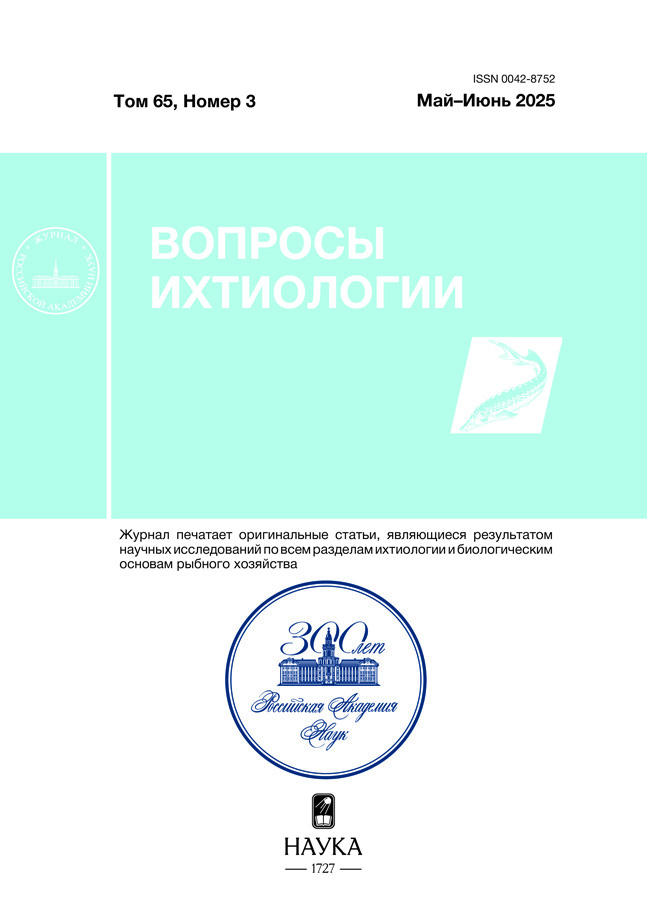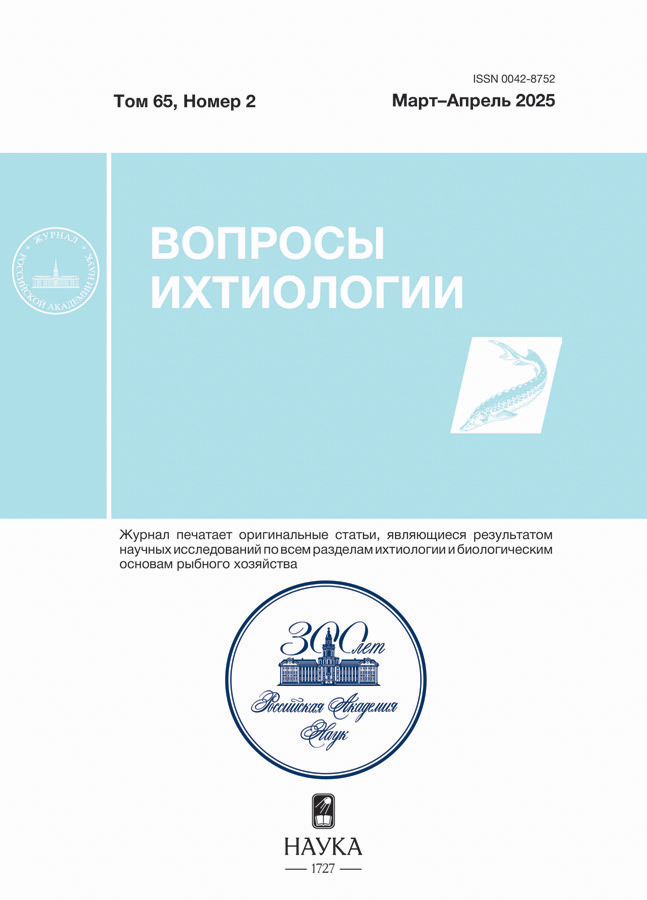Development of Pholis crassispina (pholidae) larvae from the waters mottled gunnel of peter the great gulf, sea of japan
- Authors: Balanov А.А.1, Rostovtceva М.O.2
-
Affiliations:
- National Scientific Center of Marine Biology, Far Eastern Branch, Russian Academy of Sciences
- Far Eastern Federal University
- Issue: Vol 65, No 2 (2025)
- Pages: 183-192
- Section: Articles
- URL: https://rjsocmed.com/0042-8752/article/view/683956
- DOI: https://doi.org/10.31857/S0042875225020053
- EDN: https://elibrary.ru/CUXTGR
- ID: 683956
Cite item
Abstract
The article describes the larvae and provides the main meristic features of juvenile and mature Pholis crassispina specimens from the waters of Peter the Great Gulf, Sea of Japan. An original scheme for designating melanophores is proposed. The dynamics of melanophore coloration development in larvae is described. The cleithral pigment in this species is present from the preflexion stage. At the same stage, after reaching an absolute body length of 14.3 mm, a superficial melanophore row appears on the sides of the abdomen; melanophores can have a ray structure or appear as dots. After a body length reaches approximately 18.4 mm, each postanal ventral melanophore corresponds to one segmented ray of the anal fin. From this larval length, the number of segmented rays in the anal fin can be determined by counting the number of melanophores at their bases. A set of features is proposed that allows reliable identification of P. crassispina larvae at each stage of development.
Full Text
About the authors
А. А. Balanov
National Scientific Center of Marine Biology, Far Eastern Branch, Russian Academy of Sciences
Author for correspondence.
Email: abalanov@imb.dvo.ru
Russian Federation, Vladivostok
М. O. Rostovtceva
Far Eastern Federal University
Email: abalanov@imb.dvo.ru
Russian Federation, Vladivostok
References
- Баланов А.А., Епур И.В., Шелехов В.А. 2020. Описание пелагических личинок Chirolophis japonicus и Ch. saitone (Stichaeidae) из вод залива Петра Великого (Японское море) // Вопр. ихтиологии. Т. 60. № 3. С. 271–281. https://doi.org/10.31857/S0042875220030066
- Воскобойникова О.С. 2005. О развитии скелета в онтогенезе атлантического маслюка Pholis gunnellus, анизархуса среднего Anisarchus medius и люмпенуса Фабрициуса Lumpenus fabricii (Zoarcoidei, Perciformes) // Там же. Т. 45. № 4. С. 502–511.
- Линдберг Г.У., Красюкова З.В. 1975. Рыбы Японского моря и сопредельных частей Охотского и Желтого морей. Ч. 4. Л.: Наука, 464 с.
- Макушок В.М. 1958. Морфологические основы системы стихеевых и близких к ним семейств рыб (Stichaeoidae, Blennioidei, Pisces) // Тр. ЗИН АН СССР. Вып. XXV. 129 с.
- Парин Н.В., Евсеенко С.А., Васильева Е.Д. 2014. Рыбы морей России: аннотированный каталог. М.: Т-во науч. изд. КМК, 733 с.
- Расс T.C. 1949. Икринки и личинки рыб Баренцева моря // Тр. ВНИРО. Т. 17. С. 37–38.
- Соколовский А.С., Соколовская Т.Г. 2008. Атлас икры, личинок и мальков рыб российских вод Японского моря. Владивосток: Дальнаука, 223 с.
- Соколовский А.С., Дударев В.А., Соколовская Т.Г., Соломатов С.Ф. 2007. Рыбы российских вод Японского моря. Владивосток: Дальнаука, 200 с.
- Соколовский А.С., Соколовская Т.Г., Яковлев Ю.М. 2011. Рыбы залива Петра Великого. Владивосток: Дальнаука, 431 с.
- Солдатов В.К., Линдберг Г.У. 1930. Обзор рыб дальневосточных морей // Изв. ТИНРО. Т. 5. 576 с.
- Черешнев И.А., Назаркин М.В. 2008. Первое достоверное обнаружение нового для фауны России вида маслюка Pholis (Enedrias) crassispina (Pisces: Pholidae) в северо-западной части Японского моря, с замечаниями по составу видов этого семейства в данном районе // Биология моря. Т. 34. № 5. С. 318–323.
- Якубовски М. 1970. Методы выявления и окраски системы каналов боковой линии и костных образований у рыб in toto // Зоол. журн. Т. 49. № 9. С. 1398–1401.
- An atlas of the early stage fishes in Japan. 1988. Tokyo: Tokai Univ. Press, 1154 p.
- Balanov A.A., Epur I.V., Shelekhov V.A., Turanov S.V. 2022. The first description of larvae and comments on the taxonomy of Stichaeus ochriamkini Taranetz, 1935 (Perciformes: Stichaeidae) // J. Fish Biol. V. 100. № 5. P. 1214–1222. https://doi.org/10.1111/jfb.15030
- Fahay M.P. 1983. Guide to the early stages of marine fishes occurring in the western North Atlantic Ocean, Cape Hatteras to the southern Scotian Shelf // J. Northw. Atl. Fish. Sci. V. 4. P. 3–423. https://doi.org/10.2960/J.v4.a1
- Fedorov V.V. 2004. An annotated catalog of fishlike vertebrates and fishes of the seas of Russia and adjacent countries. Part 6: Suborder Zoarcoidei // J. Ichthyol. V. 44. Suppl. 1. P. S73–S128.
- Kendall A.W. Jr., Ahlstrom E.H., Moser H.G. 1984. Early life history stages of fishes and their characters // Ontogeny and systematics of fishes. Lawrence: Allen Press. P. 11–22.
- Kimura S., Okazawa T., Mori K. 1988. Development of eggs, larvae and juveniles of the tidepool gunnel Pholis nebulosa, reared in the laboratory // Bull. Jpn. Soc. Sci. Fish. V. 54. № 7. P. 1161–1166. https://doi.org/10.2331/suisan.54.1161
- Matarese A.C., Watson W., Stevens E.G. 1984. Blennioidea: development and relationships // Ontogeny and systematics of fishes. Lawrence: Allen Press. P. 565–573.
- Matarese A.C., Kendall A.W., Blood D.M., Vinter B.M. 1989. Laboratory guide to early life history stages of Northeast Pacific fishes // NOAA Tech. Rept. NMFS. № 80. 653 p.
- Russell F.S. 1976. Fam.: Pholidae // The eggs and planktonic stages of British marine fishes. London: Acad. Press. P. 309–314.
- Tokuya K., Amaoka K. 1980. Studies on larval and juvenile blennies in the coastal waters of the southern Hokkaido (Pisces: Blennioidei) // Bull. Fac. Fish. Hokkaido Univ. V. 31. № 1. P. 16–49.
- Watson W. 1996. Pholidae: gunnels // The early stages of fishes in the California current region. CalCOFI Atlas № 33. Lawrence: Allen Press. P. 1120–1125.
- Yatsu A. 1981. A revision of the gunnel family Pholididae (Pisces, Blennioidei) // Bull. Natl. Sci. Mus. Tokyo. Ser. A. V. 7. № 4. P. 165–190.
Supplementary files

















